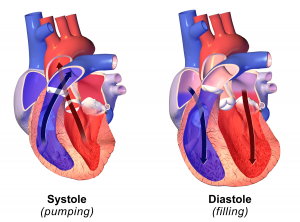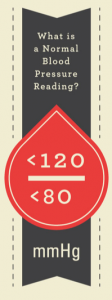 When it comes to our health, there are also numbers we must closely pay attention to, and one in particular we must keep a sharper eye on. We’re talking about blood pressure numbers; understanding your blood pressure reading can be the difference between life and death.
When it comes to our health, there are also numbers we must closely pay attention to, and one in particular we must keep a sharper eye on. We’re talking about blood pressure numbers; understanding your blood pressure reading can be the difference between life and death.
You see, the numbers that show when we take our blood pressure reveal a lot about our health. Keeping your numbers in a healthy range will help you continue a long, joyful life. If you don’t quite understand the importance of those numbers, let us break down some facts with the help of age and gender wise blood pressure chart to give you a better idea.

Photo Credit: Creative Commons/Wikipedia.org
What is blood pressure?
Advertisement
Blood pressure by name is simple – it refers to the amount of pressure put on your vessels as blood travels around your body. Your blood originates in your heart and gets pumped out to reach other vital organs and parts of your body.
Blood pressure can come in three forms: low, normal and high. Ideally, you want a normal blood pressure reading, but if it’s low or high it can have serious health consequences. Understanding blood pressure, though, goes a bit further than just recognizing its role in the body. To get a better understanding of blood pressure, you have to look at the numbers in the blood pressure chart.
Understanding blood pressure readings: diastolic and systolic

Photo Credit: Carrington.edu
You may have heard such readings like 130/86 mmHg or 123/82 mmHg, but what does this really tell us? Blood pressure readings use two numbers: diastolic and systolic.
Diastolic is the bottom number; this number is always lower and tells us the pressure on the arteries between heart beats. This is the time when the heart refills with blood. Systolic is the top number which is always higher. It reveals the amount of pressure on the arteries while the heart beats.
The American Heart Association has created recommendations for blood pressure so you can stay healthy and avoid hypotension and hypertension. The following recommendations are:
- Hypotension (too low): Lower than 90/60 mmHg
- Normal: Lower than 120/80 mmHg
- Prehypertension: 120/80 to 129/80 mmHg
- Hypertension stage 1: 130/80 to 139/89 mmHg
- Hypertension stage 2: Higher than 140/90 mmHg
- Hypertension crisis: 180/120 mmHg – emergency personnel should be called
| Blood Pressure Category | Systolic: Highest blood pressure reaches mmHg (Upper number) | Diastolic: Lowest blood pressure reaches mmHg (Lower number) |
|---|---|---|
| Low blood pressure (Hypotension) | Less than 90 | Less than 60 |
| Normal | 90-120 | 60-80 |
| Prehypertension | 120-129 | Less than 80 |
| High blood pressure (Hypertension) stage 1 | 130-139 | 80-89 |
| High blood pressure (Hypertension) stage 2 | 140 or higher | 90 or higher |
| Hypertensive Crisis | 180 or higher | 120 or higher |
When it comes to importance, systolic pressure is more closely looked at because it is what can cause higher risks to your health, even more so with seniors.
Blood pressure chart by age and gender
The chart reveals healthy blood pressure readings for age and gender that can be used a guideline. In individuals between the age group of 15 and 19, systolic blood pressure can increase with height. The variation is not observed among other age groups.
| AGE | FEMALE | MALE |
|---|---|---|
| 15-18 | 117/77 mmHg | 120/85 mmHg |
| 19-24 | 120/79 mmHg | 120/79 mmHg |
| 25-29 | 120/80 mmHg | 121/80/ mmHg |
| 30-35 | 122/81 mmHg | 123/82 mmHg |
| 36-39 | 123/82 mmHg | 124/83 mmHg |
| 40-45 | 124/83 mmHg | 125/83 mmHg |
| 46-49 | 126/84 mmHg | 127/84 mmHg |
| 50-55 | 129/85 mmHg | 128/85 mmHg |
| 56-59 | 130/86 mmHg | 131/87 mmHg |
| 60 and older | 134/84 mmHg | 135/88 mmHg |
What affects blood pressure?
There are many internal and external factors contributing to blood pressure. Because of this, monitoring it daily can give you the most accurate numbers. Here are some factors to consider in regard to blood pressure:
- Smoking
- Obesity
- Diet – high salt foods, processed foods, foods high in fat
- Age
- Race
- Family history
- Lack of physical activity – if you check your blood pressure after activity, though, it will appear higher
- Lack of potassium
- Lack of vitamin D
- Alcohol consumption
- Stress
- Chronic conditions like kidney disease
As you can see, some of these risk factors are controllable and some are not – race, age and family history. Therefore, it’s recommended that you manage your lifestyle habits to promote healthy blood pressure, especially since you can’t control your race, age or family history.
High blood pressure (hypertension)
As we mentioned, hypertension – or high blood pressure – refers to a high amount of pressure being pushed against the arteries, which can lead to cardiovascular disease.There are two types of high blood pressure: primary (essential) hypertension and secondary hypertension. Primary hypertension refers to high blood pressure without an identifiable cause and can develop over many years. Secondary hypertension is caused by an underlying condition. Secondary hypertension can occur suddenly and can result from the following illnesses:
- Kidney problems
- Sleep apnea
- Thyroid problems
- Alcohol abuse or long time use
- Use of illicit drugs
- Medications like decongestions, birth control and cold remedies
Depending on which type of hypertension you have, the causes will differ.
Related reading: High blood pressure (hypertension) may be an autoimmune disease
High blood pressure symptoms
High blood pressure symptoms may be unnoticeable for years and that is why keeping regular readings – especially if you have risk factors for hypertension – is that much more important. Symptoms of hypertension include:
- Chest pain
- Fatigue
- Dizziness
- Swelling in legs, abdomen and ankles
- Bluish color to lips or skin
- Changes in heart rate – speeding up or palpitations
High blood pressure side effects
High blood pressure is linked to serious health consequences. Here are some of the side effects and other illnesses high blood pressure plays a role in:
- Heart attack
- Heart failure
- Stroke
- Kidney disease
If you already have another underlying medical condition, such as diabetes or high cholesterol, paired with high blood pressure, your risk for these diseases vastly increases.
High blood pressure prevention

To avoid hypertension and reduce the risk of cardiovascular disease, prevention is your best defense. For primary hypertension, prevention methods include enjoying healthy lifestyle habits such as exercising, eating well, moderating alcohol consumption, reducing and managing stress and not smoking. These are simple ways you can reduce your risk of developing hypertension over time.In the case of secondary hypertension, prevention is about managing the chronic illness. If the underlying medical issue you have is not managed, it can put you at greater risk for hypertension. Following directions of medications and treatment options provided by your doctor can help you prevent high blood pressure as a result of an underlying health condition.
Related reading: Pulmonary hypertension patients can benefit from exercise training: Study
High blood pressure natural remedies
High blood pressure natural remedies are very similar to the means of preventing blood pressure issues altogether. If you lack physical activity, start now. Depending on age and ability, it may be wise to consult your doctor, but start off with some swimming or light walking – both are great beginnings to get stronger and help your hypertension.Eating a balanced diet is also essential. Fruits and vegetables should be enjoyed in abundance and the less processed and fast-food, the better you will feel. Greens, lean meats and whole grains are all part of the recipe for a healthy life and may help you lower your high blood pressure naturally.
Related reading: If you want better blood pressure avoid these popular supplements
Low blood pressure (hypotension)
As opposed to high blood pressure, we can develop low blood pressure, which is still harmful to our health. Low blood pressure can be temporary or can be chronic and something you have to manage, it all depends on the cause.Potential causes of low blood pressure are:
- Dehydration
- Heart problems
- Blood loss
- Infection
- Severe allergic reaction
- Lack of nutrients
- Medications
Low blood pressure causes can also result from standing up too quickly, can occur after a meal and can be a result of faulty brain signals or damage to the nervous system. As you can see, there are many causes of low blood pressure and doctors recognize that, for some, normal levels are just low. That is why doctors don’t usually diagnose someone with hypotension unless symptoms are visible.
Low blood pressure symptoms
Many low blood pressure symptoms are quite similar to high blood pressure ones, but there are a few differences:
- Fatigue
- Nausea
- Blurred vision
- Lack of concentration
- Cold, clammy, pale skin
- Shortness of breath
- Depression
- Thirst
- Dizziness
If you continuously have readings of low blood pressure but don’t experience these symptoms, then what may be low for others is quite normal for you. Therefore, it’s important to pay attention to any changes in health.
Advertisement
Related reading: Delayed orthostatic hypotension: Is dizziness after standing a cause?
Low blood pressure prevention and natural remedies
Because most of the time low blood pressure isn’t too serious, continuing to live a healthy lifestyle is your means of prevention and natural remedy. Drinking plenty of water and enjoying whole foods can help balance out your blood pressure. Also, the type of low blood pressure you have can also help you prevent or treat it, for example, if your blood pressure drops when you strand up or get out of bed, being more mindful of this and moving slower can help alleviate this rush and change.Either too high or too low, blood pressure should always be monitored, especially as you age. The detrimental effects of blood pressure can be life-threatening, so understanding your readings and taking the appropriate steps to healthier living is the secret to healthy blood pressure.
Infographic- Tips to Naturally Lower your Blood Pressure
